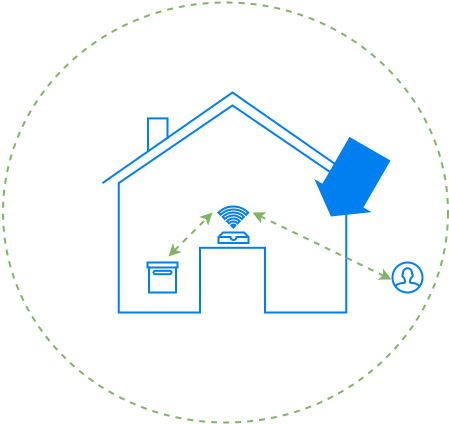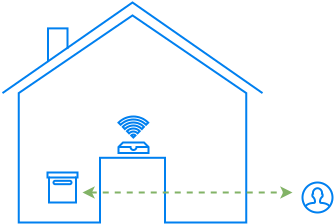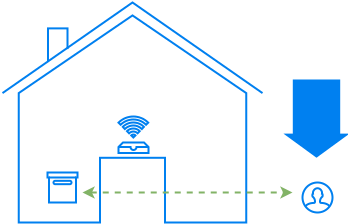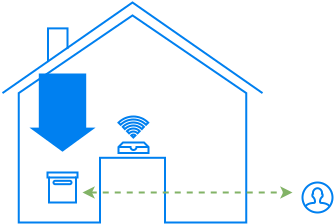(Originally posted here)
This is the second part of Building secure connected devices. The first is available here.
In
the first part we looked at the typical attack vectors for remotely
accessing connected Wi-Fi devices in the smart home. These attacks could
let an attacker control any device half way across the globe. In this
part, we will consider the common attack vectors for the (a) local
network access and (b) physical access of connected devices.
Local Network Access
Most
connected devices offer a local network API for smartphones/laptops to
use. The smartphone can query and configure the connected device using
these APIs. This allows super fast exchange of information without
having to go through the cloud.

Typically,
for most homes, the Wi-Fi Access Point enforces a MAC-level security
like WPA/WPA-2. This ensures that a phone/laptop cannot get on the Wi-Fi
network or read/write packets unless it has a correct secret,
passphrase / key, for the network. Since this secret is handed over by
the home owner to other persons, it is assumed that anyone getting
access to the Wi-Fi network is a trusted person.
This
level of security works for most products. It relies on the the Access
Point to identify authorized accesses, thus exposing these APIs to
anybody as long as they are on the local network.
Additional Cryptography Layer
Some IoT products/ecosystems, like Apple HomeKit,
go one step further and implement an additional cryptography layer on
top. With this method, the APIs exposed on the local Wi-Fi network are
also secure. A client smartphone/tablet requires an additional device
secret for it to interact with the device, even though it is on the
local Wi-Fi network.
Once
this cryptography layer is established, a role based access control
could also be implemented. With this you could define what the kids in
the house can control as opposed to you or your wife.
Connected
devices that implement this should note that it does affect the user
experience, particularly for novice users with multiple devices,
multiple clients and their differing roles. Care should be taken to
expose it intuitively such that it doesn’t become too complex for users
to not use it, or misuse it.
Reset Network Settings
The
above mechanisms protect the device as long as it is connected to the
home Wi-Fi network. Given the above, an attacker might try to force the
device to forget its network configuration settings. If the connected
device forgets the configuration of the home network, it will typically
enter into a configuration mode where it lets a user configure the home network (we will discuss this soon in the next subsection).
Hence,
care should be taken to ensure that any action that makes the device
forget the home network settings is a deliberate action taken by an
authorized user.
New Device Setup
When
an end-user brings a smart device home, say a connected light bulb, the
first thing that the user has to do is configure it so it can connect
to the home Wi-Fi network. Since most of the ‘things’ in IoT are
headless, this implies that the user cannot simply enter the network
name and its passphrase into the device using the device’s keyboard or
touch-screen.

There
is a wide variance in the methods for performing this network
provisioning step for IoT. This uses some communication mechanism
between the user and the smart device to securely transfer the home
Wi-Fi network’s credentials. There are many communication mechanisms for
this transfer, using NFC, IR, light among others.
The thing to remember in new device setup is to always authenticate the other endpoint
The
most common mechanism, that I have seen, is where the smart device
hosts its own temporary wireless network. A user’s smartphone can then
connect to this temporary wireless network, and then transmit the
information over this network.


Given
the above, can a malicious user configure the smart device to connect
to a malicious Wi-Fi network? Or can a neighbor configure my
grandfather’s thermostat to connect to her Wi-Fi network?
OR
Can
a fake device be created to deceive the real owner to configure the
fake device to their home network? Can my grandfather accidentally
configure my neighbor’s fake thermostat to connect to his Wi-Fi network.
In the process revealing his Wi-Fi network credentials to the neighbor?
The thing to remember in implementing new device setup is to always authenticate the other end point.
The
smart device, being configured, should only let the real owner of the
device configure it. This can be done by using some kind of proof of
possession, like a secret on the box, or press of a button, or a state
of the device. This allows the user to prove that she really owns the
device that she is configuring.
On
the other hand, the app (smartphone/laptop) that configures the smart
device should ensure that it is talking to a genuine smart device that
is owned by the user, and not a fake one. This can be done by using some
kind of PKI or a challenge-response mechanism.
Physical Access
The
final way of interacting with the device is physically accessing it,
the old non-IoT way. Physical access is often used for establishing
proof of possession and ownership for the local and remote accesses.
Now
let’s look at attack vectors where an attacker tampers with a connected
device, and then gives the device to the unsuspecting end-user. The
goal of the tampering is to eventually either snoop data from the
connected device, or write data/commands to the connected device, or
perform a DOS.
From
an attack point of view, this requires physical presence around the
device, it isn’t possible to execute this kind of an attack remotely.
Either the attacker’s presence in the home, or his access to the device
before it is brought in the home, is required for such an attack. The
effort required for such an attack may probably justify a relatively
high-profile target, but as IoT penetrates deeper into our surroundings
and becomes a norm, this isn’t unthinkable.
Basics
If
any embedded developer is asked to hack open a device, the first thing
he would do is try to get access to the device console or the debugger
interface (JTAG/SWD). These should definitely be disabled in production.
Also
to note is that any data or firmware on the device flash can be read or
modified by removing the flash parts. Security researches frequently do
that for analysis [pdf]. Hence, any sensitive data stored on the flash should be encrypted.
Trusted Boot
If
data can be written to flash, an attacker could modify the firmware
that is stored on the flash. An attacker could, for example, simply
change the server URL and server certificates in-place to those of a
malicious server. With such a change the connected device may start
reporting data and accept commands from a malicious server without the
user ever realizing it.

Many
micro-controllers, and most processors, offer trusted boot execution.
With such a mechanism, only the firmware that is encrypted and signed
with a valid set of keys is executed on the device. The keys are private
to the device maker. With trusted boot, if the firmware is maliciously
modified as described above, the processor will simply not load the
firmware, thus thwarting the attack.
Device Phishing
All
these precautions could be taken, but what if someone builds a clone of
your device, with exactly the same look and feel, but with an
altogether different firmware.
For
most home devices, the first use of the device starts with phone
applications. The phone applications should validate the genuineness of
the device. The PKI mechanisms that are used for validating that the
remote servers are genuine can also be used for validating that the
device is original.
Firmware Upgrades
A
big advantage of connected devices, over standalone devices, is they
can be automatically upgraded to provide newer features. From a security
standpoint, as newer attack vectors or vulnerabilities are detected,
this allows the manufacturer to fix the issues in the field and provide
customers with a more robust product. As Wi-Fi connected devices can
directly talk to a remote server, they can periodically look for these
upgrades, and automatically download and install these upgrades
themselves.
Interestingly,
the firmware upgrade mechanism can also be misused to deploy malicious
firmware across all your products deployed in the field.

As with the remote access
scenario, do ensure that the servers, that the firmware upgrade will be
fetched from, are authenticated with TLS (certificates).
As
an additional layer of security, also sign and encrypt your upgrade
images. Using different keys for different product lines should also be
helpful. This additional layer of security ensures that even if the
cloud services are compromised for some reason, the connected devices
reject the firmware images that may be tampered with.
That
concludes this two part series about Building Secure Connected Devices.
If you are building a Wi-Fi enabled devices, these articles hopefully
serves as a good reference to influence your product implementation.
Note: Thanks to freeimages for the image of the envelope/seal and pixabay for the image of the lockers.
No comments:
Post a Comment